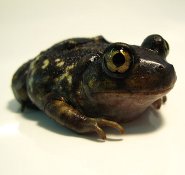
The
Eastern Spadefoot (
Scaphiopus holbrookii) is a burrowing toad found east of the Mississippi river. From the southern part of New England to the Florida Keys and as far west as Louisiana, these frogs can be found in forested lowlands with sandy or loose soil. They are commonly found on the banks of rivers prone to flooding, but seem to be absent form the higher altitudes of the Appalachians and the Everglades.
To blend in with the leafy forest floor, the Eastern Spadefoot is usually olive green, brown, gray, or black in color. It is about two to three inches (42 - 72 mm) long with two yellowish lines, which are more prominent in the males, starting from behind the eyes and running down the back. The underside of the body is usually white or grayish in color.
Although they are considered toads, they lack certain toad-like qualities. Their eyes are large and bulging, and unlike other toads, the pupils are vertical instead of horizontal. Their softer bodies and smoother skin is unusual for a toad, and they lack the paratoid glands on each side of the head.
The long, sharp, sickle-shaped shade on each hind foot is responsible for the Eastern Spadefoot's common name. Since these toads spend most of their time underground, these spades are used to dig burrows.
Quite secretive, the Eastern Spadefoot will usually only emerge to feed or during mating season which usually lasts from March to September. They will come out their burrows at sundown during warm, heavy rains and begin their mating ritual in shallow, temporary pools created by flooding or rain. Eggs will be laid in these pools and hatch within a week. Tadpoles will then transform within a few weeks to a couple of months.
Although the Eastern Spadefoot, like most toads, is threatened by other toads and snakes, the toxin secreted by their skin usually protects them from predators. Since the eggs are laid in temporary pools, the tadpoles don't have to worry much about being eaten by fish, but there is still a threat of other frogs and toads looking for a snack.
Tadpoles usually feed on plankton, and the adult Eastern Spadefoot will feed on many insects, including beetles, flies, and crickets; the occasional meal of earthworms, or small vertebrates such as salamanders is not unheard of.
Due to people increasingly encroaching into wild, the Eastern Spadefoot is considered endangered in many areas. Pennsylvania, Connecticut, Ohio, Massachusetts, and New York are some of the states that have reported a decline in this elusive toad population.
Picture of the eastern spadefoot by Riechvaugen, licensed under
GFDL
 More...
More...













